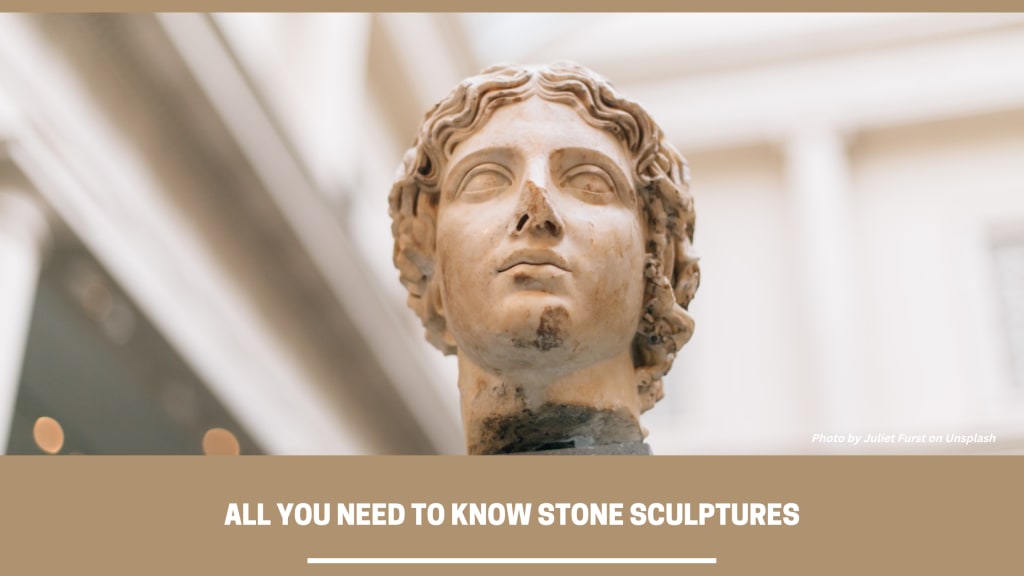All You Need to Know Stone Sculptures
Stone carving and stone sculpture fabrication evolved from these humble beginnings to become one of the most fundamental components of sculptural art.

A stone statue is the oldest surviving form of artistic expression. The fundamental techniques and concepts of stoneworking have tens of thousands of years of history behind them. Many aspects of humanity's cultural past can now be seen only through the lens of ancient stonework. This is due to the adaptability and durability of the stone. Monolithic monuments, archaic inscriptions, and carved prehistoric figures are examples of early or primitive stone sculpture. Stone carving and stone sculpture fabrication evolved from these humble beginnings to become one of the most fundamental components of sculptural art.
There is a great deal of variety in the field of stone sculpting. Diverse works have resulted from a variety of materials, techniques, subjects, and styles. Common materials include soapstone, alabaster, sandstone, limestone, and marble. Each is chosen for a variety of factors such as softness, availability, and colour or finish.
How Are Stone Sculptures Carved?
Hand tools, primarily the hammer and chisel, have traditionally been used to work with stone. Throughout history, the use of tools and skills has enabled artists to perform almost all types of stonework. Natural stone sculpture is not always created with these tools, but they are unquestionably the most common.
Artists now have a plethora of tools at their disposal, in addition to the hammer and chisel, to create their works. Pneumatic chisels, diamond-tipped saws, high-pressure water jets, and even industrial lasers are now used by some artists.
Many people, however, still prefer the old way of doing things. An artist who carves a sculpture with hand-made tools is just as likely as one who uses industrial technology. The process is essentially the same regardless of the tools used.
Types of Stone Carving
Since the discovery that he could shape stone by striking it with a harder material, man has been creating art. Sculptors have used a few different types of stone over the millennia. The most common ones for carving from the three types of rock are listed below: igneous, sedimentary, and metamorphic.
Igneous Rocks
The process by which igneous rocks formed determines their characteristics. Magma poured through the older solid rock deep within the earth due to the great heat of volcanic activity, creating granite, basalt, and diorite rocks. Granite is made up of quartz crystals that contain silica and feldspar. It is one of the most popular rocks used by stone sculptors.
Because of its hardness, granite is a difficult stone to carve. In fact, because you're pulverising rather than driving the chisel through the stone, you might not call the process carving.
Sedimentary:
Weathering moves rock fragments to a basin or depression where sediment is trapped. Sedimentary rock is formed when crushed sediments are buried deeply. Sandstone and limestone are two common sedimentary rocks used in Indian stone sculpture.
Limestone is easy to carve and can accommodate minute details, but it is also tough enough to withstand undercutting. While it does not have the inherent beauty of more bright stones, it can be textured in a variety of ways to bring the statue design to life. There is a distinct 'grain' or bed in limestone that is formed by layers of sediment heaped on top of each other.
Limestone can be polished, but the shine fades quickly in an outdoor setting. You can protect your exterior stonework from nature by taking preventive measures. Despite its flaws, limestone appears to be more acid rain resistant than marble, making it an excellent choice for outdoor stone sculpture.
Sandstone, on the other hand, is composed of silica or calcium carbonate, which holds sedimentary sand together. Large pieces of sandstone can be broken off while travelling in the bed direction. When working with sandstone, your tools will quickly wear out.
Metamorphic:
When a sedimentary layer is heated and pressed, it undergoes a chemical transformation that results in the formation of a new crystalline substance. Metamorphism causes limestone to change into marble. Metamorphic rocks that are used by stone sculptors include marble, alabaster, and soapstone.
Marble has been the most popular stone for sculptures for centuries. It is a moderately difficult material to work with. It will be able to store a great deal of fine detail. Marbles come in over 200 different colours. Onyx marble, for example, is a decorative stone that is used for flooring, countertops, and walling. When polished to a high lustre, its crystalline structure glows. Other stone crafts, such as pietra dura, are made from various types of marbles, in addition to stone sculptors.
Alabaster is a fragile stone that flakes and splits along hidden fissures. A high polish will be required to bring out the fantastic colours and patterns. Indeed, the stone is so beautiful that the visitor may overlook your sculptural forms and concentrate solely on the stone.
Soapstone (steatite) is a soft stone that can be carved with a knife. It has a slick, soapy texture and is made of talc. The stone can be polished while retaining the delicate texture detail. If you are new to stone carving, this is a good place to start and practise.
Conclusion
The emphasis in stone carvings is not only on physical features but also on more profound aspects of the rock. Various wall coverings, planters, and other designs are expertly engraved into stones, resulting in stunning works of art. These stone crafts are extremely popular, and they represent lovely components of beauty and charm in today's world.
About the Creator
Amit Kumar
Full-time thinker & part-time writer...






Comments
There are no comments for this story
Be the first to respond and start the conversation.